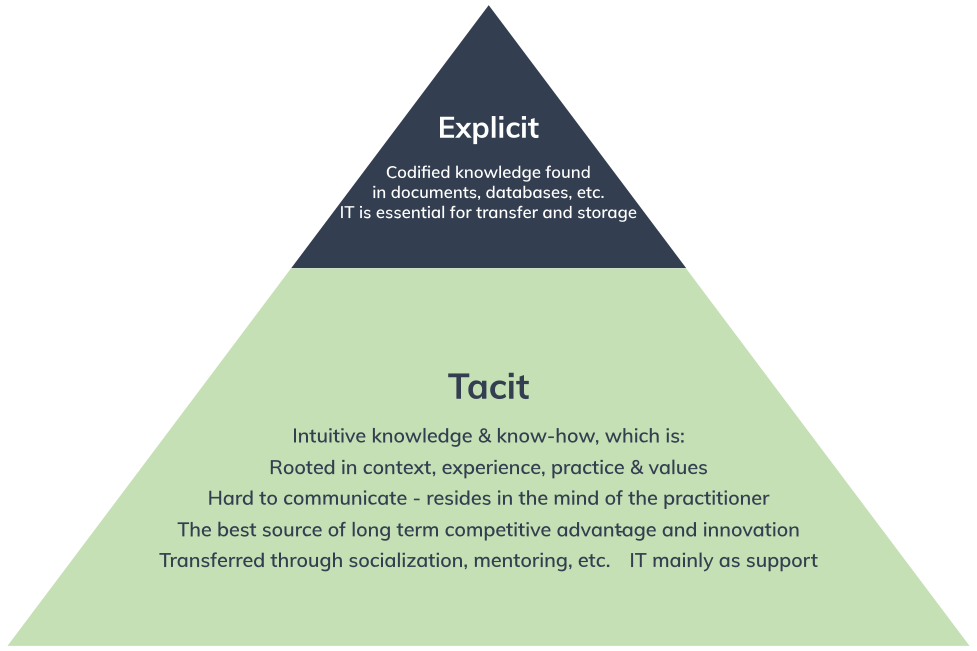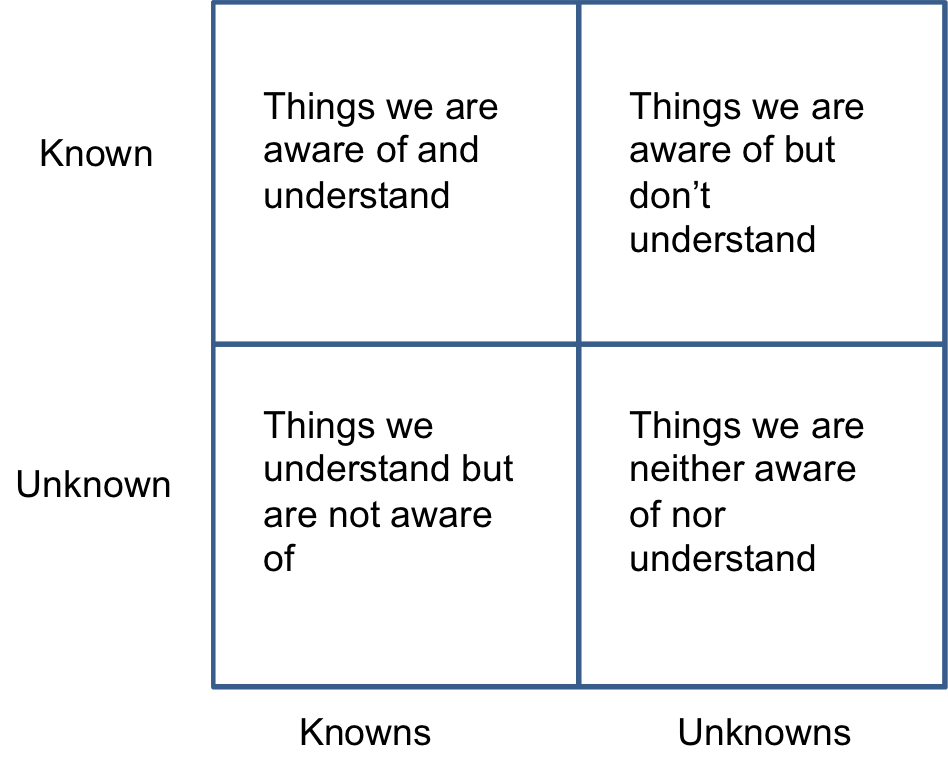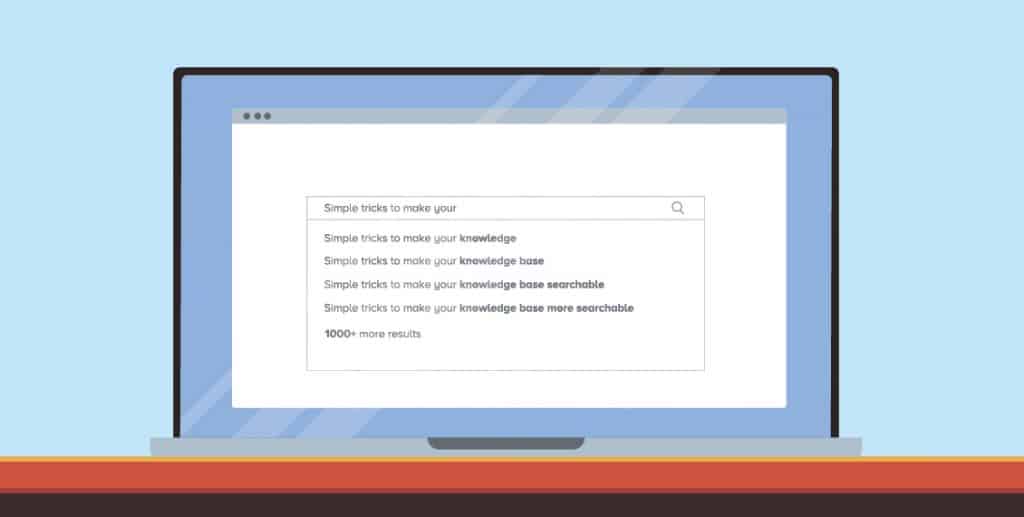The knowledge possessed by your team members is one of your organization’s most valuable assets.
This just makes sense:
The more organizational knowledge your team has about the products and services you offer, your customers’ needs, and your industry as a whole, the more productive and successful your company will be.
Now, in many cases, the knowledge possessed by your team members is easily documented and communicated.
This knowledge—known as explicit knowledge—can take the form of step-by-step instructions, concrete answers to frequently asked questions, records of customer interactions, and more.
Sometimes, though, the knowledge held by your employees is a bit more difficult to communicate or document.
But, it’s not impossible to do so.
In this article, we’re going to dig deep into the concept of tacit knowledge.

Specifically, we’ll discuss:
- What is tacit knowledge
- Why capturing tacit knowledge is essential to your company’s success
- How to capture tacit knowledge and convert it into concrete, explicit knowledge
Let’s dive in.
What is Tacit Knowledge?
Tacit knowledge refers to the knowledge, skills, and abilities an individual gains through experience that is often difficult to put into words or otherwise communicate.
Tacit knowledge is sometimes known by a few alternate terms, such as:
- Experiential knowledge
- Tribal knowledge
- “Know-how” knowledge
The term “tribal knowledge” refers to the fact that tacit knowledge often spreads throughout an organization without being documented—and possibly never actively pointed out or discussed.

(Source)
Similarly, “know-how” refers to the idea that, sometimes, an individual just can’t explain how they know what they know (or know how to do).
For example, a professional golfer may be able to hit a ball 300 yards down the fairway, but may not be able to communicate a complete break down of every single thing they do when swinging a club to make it happen.
Consider a more relatable example: driving a car on the highway. Reflect on your instinctive ability to apply just the right amount of pressure to the brakes, avoiding stopping too short (risking a rear-end collision) or too late (colliding with the car in front). While a manual can teach you how to use the brakes (explicit knowledge), your ability to use them effectively stems from experience (tacit knowledge).
While a manual can teach you how to use the brakes (explicit knowledge), your ability to use them effectively stems from experience (tacit knowledge).
If your organization relies heavily on experience-based knowledge, consider using a reliable knowledge base software to document and scale it. It’s a smart way to retain critical know-how and make it accessible to the whole team.
Additional Examples of Tacit Knowledge
A few, more pertinent examples of tacit knowledge:
- Being able to identify the exact moment a prospect is ready to hear your sales pitch
- Knowing just the right words to use within your copy to attract and engage your audience
- Knowing which specific piece of content to deliver to a customer based on their expressed needs
Examples of Explicit Knowledge
In contrast, explicit knowledge related to the above examples might be:
- The stages of your documented sales process
- Your brand’s content style guide
- Your brand’s content library and its specific content
Difference Between Tacit, Implicit, and Explicit Knowledge
Sometimes the terms "tacit knowledge" and "implicit knowledge" are used interchangeably, but they're not entirely the same.
In simple terms, implicit knowledge is a form of tacit knowledge that can potentially be made explicit with some effort or reflection. It lies between tacit and explicit knowledge and represents subconscious understanding or assumptions that individuals may not immediately be aware of.
For implicit knowledge to become explicit knowledge, it requires more than just recording the information verbatim. It involves a process of reflection and translation of the subconscious understanding into an easily communicable format.
It's crucial to note that knowledge isn't strictly classified as either explicit or tacit. Instead, we should consider each piece of knowledge possessed by an organization on a continuum, ranging from purely tacit to entirely explicit.
Take, for example, your sales team's documented process for pitching to a customer. The overall document clearly outlines the steps to take throughout the process—an example of explicit knowledge. However, within each step, there may be certain "know-how" aspects that your sales team intuitively understands but might not be obvious to others without their experience and expertise.
So there you have it!
The key differences between tacit, implicit, and explicit knowledge come down to how easily they can be communicated and documented. While tacit knowledge is elusive and hard to articulate, implicit knowledge is subconscious but can potentially be made explicit, and explicit knowledge is straightforward to share. By understanding these distinctions, you can create an environment that nurtures learning, sparks innovation, and drives growth within your organization.
The Benefits of Capturing Your Organization’s Tacit Knowledge
Now that you understand what tacit knowledge actually is—and how difficult it is to capture—you might be left asking:
Why should my organization bother capturing our tacit knowledge and codifying it into explicit knowledge in the first place?
To be sure, there are many benefits of capturing tacit knowledge, such as...
1. Communicate Organizational Knowledge More Effectively
Earlier, we mentioned that tacit knowledge is sometimes referred to as “tribal knowledge”, as team members often “absorb” it simply by gaining more experience working within an organization.
The thing is, though:
Relying on this osmosis-like transfer of knowledge leaves up to chance whether it actually happens or not. Unfortunately, even your longest-lived employees may not gain the tacit knowledge needed to best do their jobs.
Worse yet, it may be the case that your team members don’t know what they don’t know. Basically, this means they’ll continue to use a sub-par approach to their duties simply because they aren’t aware that there’s a better way to do them.

(Source)
(This especially applies to remotely-operating teams, as employees have minimal interactions with one another—meaning much fewer chances to exchange and absorb knowledge.)
That said, the main benefit of being able to transfer tacit knowledge is that it makes this information visible and accessible to all members of your team.
It also clarifies any confusion or uncertainties your team members may have about a given process, allowing them to dig into the “nitty-gritty” details to cement their understanding for good.
The ability to capture your tacit knowledge also allows you to onboard new employees more efficiently. The typical onboarding process involves teaching newbies what the steps of various processes are.
Injecting tacit knowledge into the mix allows them to get a feel for how to optimally perform these tasks.
Similarly, codifying your tacit knowledge adds value to your current, explicit knowledge content. For example, you might supplement a standard operating procedure document with a video in which an employee demonstrates the procedure in action.
In supercharging your current knowledge content, your team will be better equipped to tackle any and all processes they’re responsible for. This can lead to a massive spike in productivity throughout your organization.
Injecting tacit knowledge into your external knowledge base will have a similar effect on your customers. Here, your knowledge base content won’t just tell your customers what to do—but will also explain just how to do it. This will equip them to get the absolute most value they can from your products or services.
Overall, tacit knowledge becomes useful and valuable to others only when it’s shared by those who possess it. By documenting it concretely, you allow each of your team members to share their tacit knowledge with ease.
2. Differentiate Your Company from Your Competitors
As we mentioned earlier, the ability to store and share tacit will better equip your organization to serve its customers—and can also better equip (and enable) these customers to solve their own issues as they wish.
With a comprehensive knowledge management system full of “know-what” and “know-how” information, both your support staff and your customers will always be able to find what they need to overcome the issue at hand.
If your customers can always get the info they’re looking for when engaging with your brand, they’ll have every reason to trust you over your competition moving forward.
What’s more, simply showcasing your tacit knowledge to your audience—even if they don’t necessarily need it at the moment—helps position your brand as a team of experts. If your competitors don’t offer similar content to showcase their value, you’ll already have a pretty hefty advantage over them.
3. Gain Knowledge Capital and Retain Organizational Knowledge
We’ve established that your organization’s tacit knowledge is a valuable asset.
And we don’t mean this symbolically, either.
Your team’s documented tacit knowledge is proof that your team knows what it’s doing, and that your company is a valuable entity.
For employee candidates, it provides insight into your organization’s vision, goals, and capabilities. This can attract high-quality candidates looking to work with a team as skilled and dedicated as they are.
For investors and other stakeholders, it’s proof that they can continue working with your business with confidence—and that doing so will pay off in dividends.
And, if your goal is to eventually sell your business, your documented tacit knowledge offers buyers proof that your company is made up of a highly-skilled and knowledgeable team of employees.
Knowledge capital is also valuable to your organization, as well.
As we said earlier, documenting tacit and other knowledge makes employee onboarding much easier.
The other side of this is that you’ll also retain previous employees’ knowledge once they leave your organization.
This can help your current employees pick up the slack as you search for a replacement hire, and also enable your new employees to hit the ground running.
4. Increased Productivity & Organizational Innovation
Since you’ll have collaboratively developed and demonstrated best practices and optimal approaches to tasks, you’ll almost certainly perform at a much higher level.
Moreover, this type of knowledge sharing and knowledge transfer where individual team members can learn from each other's experiences and mistakes will allow employees to spend less time and energy on ideas that don't work.
This open exchange of ideas and experiences allows employees to gain new perspectives and see things from different angles which can lead to breakthroughs, “aha moments,” and other outside-the-box ways of thinking.
Documenting your organization’s tacit knowledge may take some effort, but doing so is always well worth it.
That is, as long as you approach the process in a strategic manner...
How to Convert Tacit Knowledge Into Explicit Knowledge
Okay, so:
We know what tacit knowledge actually is.
And we know why it’s important—even essential—for your team to document it.
Now, let’s talk about how to actually capture and document tacit knowledge.
Create an Environment Centered on Continuous Learning
Your first order of business will be to get your team focused on collecting and documenting tacit knowledge as a matter of course.
Audit Your Current Knowledge Content and Identify Knowledge Gaps
To get started, here, you’ll first need to audit your current knowledge content—both related to tacit knowledge and overall. As a team, comb through your knowledge content, assessing each piece for:
- Comprehensiveness: Does the content cover every aspect of the topic? Is anything left unsaid or unexplained? Do words fall short of truly showcasing the knowledge in question?
- Digestibility: Is it easy to read or otherwise consume the knowledge content? Is there a more effective and efficient way you could communicate the information in question?
- Applicability: Does your knowledge content allow the user to take action? Will taking said action lead them to the outcome they expect? Do they need anything else to move forward productively?
You also want to think of any knowledge-related questions, comments, or feedback you’ve received from your team or your audience. Similarly, you can look at your team’s and individual employees’ performances to see where improvements need to be made.
The goal here is to identify two key things:
- Knowledge and skill gaps within your organization that could be filled by documenting tacit knowledge
- Gaps within your knowledge base, again to be filled with documentation of tacit knowledge
Build Intentional Learning Into Your Processes
Because of its intangible nature, it’s easy to overlook or take for granted the tacit knowledge flowing through your organization at all times.
So, it’s vital that your team becomes more intentional in their efforts to identify and capture any sort of learning that takes place throughout a given process.
The key to building this intentionality: Create opportunities for your team to share their knowledge, expertise, and experiences with one another.
Employee training methods like mentorships or shadowing allow veteran employees to not just share information with new employees, but also actively train them to adhere to best practices for certain processes.
Here’s how a guided experience works:
- The new employee observes or shadows an experienced employee as they go through a given process
- The new employee then goes through the process, with the expert providing guidance and feedback along the way
- Once they’ve completed the task, the pair will discuss any challenges, problems, or other issues that may have come about
- The newbie then assumes the role of the expert, providing guidance to the expert (playing the role of an inexperienced employee learning from the newbie’s directions)
- The expert will gauge the new employee’s understanding of the process—tacit knowledge and all—and will discuss their assessment with their partner
You might also create knowledge cafe sessions, which are aimed at facilitating team-wide discussions on specific topics.
Here, the process is as follows:
- After breaking into small groups, your team members will begin exploring the many facets of the topic at hand. During this time, they can write, draw, list, brainstorm, or do anything else that’s conducive to the creation and spread of tacit knowledge.
- After a period of time, certain members of the group will rotate out, while others will stay put. Once new groups have been formed, those that stayed will review the previous discussion, then new members will discuss theirs. This process can be repeated until everyone has rotated to all groups.
- The group as a whole will come back together for a “town hall”-like meeting. This wrap-up discussion will be about reflecting on new knowledge, insights, and other such information, as well as any breakthroughs that may have occurred throughout the session.
Finally, you’ll want to focus on documenting tacit knowledge whenever discussing lessons learned with your team.
This means thinking more abstractly about the intangibles and “know-how” exhibited by your team that led to a positive (or not-so-positive) outcome.
From a-ha moments to on-the-fly changes to your procedures, there will likely be a number of things worth discussing that otherwise typically go overlooked.
Before moving on, note that, to create an environment focused on continuous learning, you may need to realign your employees with your company’s overall vision.
Without taking this critical step, it will be difficult for your team to even recognize tacit knowledge in the first place—let alone effectively document it.
Inject Storytelling Into Your Knowledge Management System
Now that you’ve identified, fleshed out, and solidified your team’s tacit knowledge, you’ll need to find a way to codify it so that it more easily be documented.
This is where knowledge management (KM) comes in.
Knowledge management tries to find ways to visualize tacit knowledge and convert it into explicit knowledge to better enable knowledge sharing and knowledge transfer with other individuals within a group.
The key to doing this:
Storytelling.
As opposed to explicit knowledge (which can be communicated in concrete terms, such as a step-by-step list), tacit knowledge is best understood through experience.
In lieu of actually providing an experience to your learner, the next best thing is allowing them to experience it vicariously through your team members.
The idea here is for your audience to be able to see themselves doing the things being discussed within the content.
It allows your team to convert their experiential learning into immersive content to be experienced by others.
More than just reading the steps of how to troubleshoot an issue, you want them to actually picture themselves fixing it in real life.
Storytelling content centers around the actions, thoughts, and ideas a veteran employee exhibits as they go through a certain process.
Again, in addition to explaining how to go about the process, the content will dig into any insights or a-ha moments uncovered along the way.
Often, storytelling content takes the form of an interview but is a bit more open-ended. On one end, the interviewer/content-creator will loosely guide the conversation in order to weave a powerful story.
On the other, the interviewee/expert will have plenty of opportunities to dig into the intangible aspects of the process that can’t be documented otherwise.
Because of this “intangible-ness”, the most effective way to deliver storytelling content is through video. That way, your user gets visual, audio, and textual content surrounding a given topic—all meant to create the immersive experience we mentioned above.
Once you’ve created this content, you can then add it to your current—and more explicit—content within your knowledge management system.
By providing both explicit and tacit knowledge to your knowledge management system, you add even more value to an already invaluable resource.
Tacit Knowledge: The Key to Organizational Excellence
Tacit knowledge plays an indispensable role in the success and growth of any organization. This often intangible and experiential form of knowledge, gained through years of practice and experience, complements explicit knowledge by providing the critical "know-how" and insights that enable individuals and teams to excel in their roles.
Understanding and valuing the importance of tacit knowledge allows organizations to harness the collective wisdom of their team members, fostering a culture of continuous learning, innovation, and adaptation. By creating opportunities for knowledge sharing, collaboration, and mentorship, organizations can effectively tap into their employees' tacit knowledge, bridging gaps and empowering everyone to grow together.
In a rapidly evolving business landscape, recognizing and leveraging tacit knowledge not only sets organizations apart but also contributes to their long-term success and competitiveness. By embracing the power of tacit knowledge, you will unlock the true potential of your organization, harnessing the collective experience and expertise of your team members to drive excellence and growth.
As part of the process of harnessing of managing and enabling employees to use tacit knowledge effectively, a knowledge base becomes an essential tool. By creating a well-structured knowledge base, you provide your employees a central repository where tacit knowledge—transformed into accessible, explicit content—can be stored, shared, and continuously updated. This ensures that invaluable insights and the nuanced understanding of experienced team members are not lost but are instead preserved for ongoing and future reference.
Our knowledge management software is a user-friendly platform to aid with this critical aspect of ensuring that tacit knowledge is both preserved and shared effectively. With our software, you can easily create, manage, and optimize your knowledge base so that it's tailored to your unique needs. The best part is that we're offering a free 14-day trial so that you can experience firsthand just how our software streamlines the integration of tacit knowledge into your daily operations.

![The Best Knowledge Management Software & Tools [2025]](https://static.helpjuice.com/helpjuice_production/uploads/upload/image/4752/direct/1576239609895-1569878329114-Knowledge%20Management%20Software.png)
